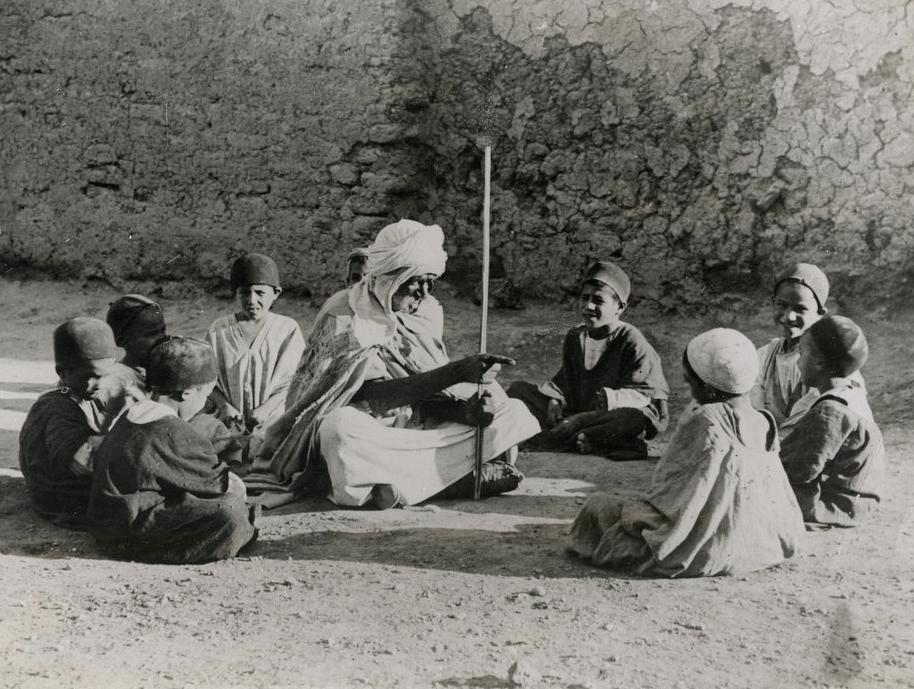
Algerian Schools: Pre-Colonial Era

Figure 1.--The French began to colonize North Africa at about the same time that photography was invented (1839). As a result, there are no photographic images of the pre-colonial era. We do not begin to see photographs until the 1860s. But the images for the Middle East and North Africa into the early-20th century show an extrodinarily backward region virtually unchanged for centuries. It is difficult to understnd how society could hve entered the 20th century virtully unchanged for a milenium. Thus we have images of how arab children were taught before the arrival of the French and other Europeans. Here we see Algerian Muslim children at a open air school in Bikara, Algeria. Note that there is no one item in this photograph that would prevent the same photograph bein taken in the 8th century AD when the Arans arrived in the region. The press caption read, "Little Arabs at open air school: It will be seen tht this rab schoolmaster, who is holding an open air class at Bikra, North africa, is a believer in he motto 'Spare the rod and spoil the child.' The photograph was taken in 1933. Note that only eight boys and no girls are being taught. Their education may seem promitive. But thy are the lucky ones. Most children for centuries received no education at all.
|
|
Until the arrival of the French, education in Algeria was very limited. There was some limited education conducted through the mosques, some of which established madrasas for boys. This was not just in Alhiers, but other towns as well. This varied over time depending on economic conditions. Some of the madeasa were of some importance. We note little sniptes here and there anout some of these madraas. One reports indicates that the trading center of Tlemcen at the peak of its success (early 14th century) was a prosperous city with a population of some 40,000 people. [Ehret, p. 334.] It is said to have supported several well-known madrasas. There were also respected madrasas in Constantine. The curriculum at these madrasas was largely limited to reading Arabic and memorization of Koranic texts. The main aim of Madrada education throughout the Muslim world was to memorize the Koran in classical Arabic and to inculcate the students with Islamic religious precepts. The pupils who successfully memorized the Koran were considered to have succeeded in their basic education. This was a minority of the students. Not only were only a small number of algerian boys educated at these schools, but most graduates did not acquire the basic elements of literacy as we would assess it today, both reading and writing. Nor was rudimentary mathematical knowledge an important concern. As far as we can tell, attendance at these madrasas was very limited and literacy rates in Algeria very high. We have not found any definitive assesments of literacy levels. One report claims that literacy rate in Algeria at the time of the French invasion was 40 percent. This seems very high, especially as girls were not educated as this estimate has to be taken with some skepticism. One author claims that madrasas (zaouias) taught basic literacy to a large proportion of children even in quite remote mountainous areas. [Ruedy, p. 103.] He uses the term 'children', but suspect he is talking about boys. And he raised the possibility that literacy rate were higher than in France. One reason we are somewhat skeptical about these claims is that the author is taking the politically correct route o trying to point out that Algeria was not as backward as commonly believed in the West. And he and others do not ask the obvious question. If the Algeiand were so literate, why were they so backward? We have been unable to obtain definitive evidence of a high literacy rate. And we suspect that whatever reading that took place was mostly the Koran and other religius texts. We do know that Algeria indigenous society was virtually unaffected by the scientific, medical, technical, and industrial sweeping through Western Europe. This was in fact the general pattern in the Arab world for centuries. This was reflected in Arab society. With the development of photography (1839), we have images of Arab life in the 19th century. There had veen so littkle changec in Arab society that many of these early photigraophs coukld have ceasily been taken centuries earlier. It is notable that we see no technical or scientific advances in the Arab world since the 13th century. This is important because many in the Arab world attempt to explain the region's backwardness to the European colonial era. In fact the Algeria the French encountered, and the same was the case in other countrie, was essentially a medieval society. Virtually all the modern infrastructure that independent Algeria inherited was the product of the French colonial era.
HBC-SU

Navigate the Boys' Historical Clothing smock pages
[Main smock page]
[Main school smock page]
[French school smocks]
[Italian school smocks]
[Other school smocks]
Related Chronolgy Pages in the Boys' Historical Web Site
[Main Chronology Page]
[The 1880s]
[The 1930s]
[The 1940s]
[The 1950s]
[The 1960s]
[The 1970s]
[The 1980s]
Related Style Pages in the Boys' Historical Web Site
[Smocks]
[Berets]
[Long pants suits]
[Shortpants suits]
[Socks]
[Eton suits]
[Jacket and trousers]
[Blazer]
[School sandals]
Navigate the Boys' Historical Clothing School Pages
[Return to the Main Algerian school page]
[Return to the Main Middle-Eastern and North African school page]
[Return to the Main African school page]
[Algeria]
[Australia]
[Belgium]
[England]
[France]
[Germany]
[Ireland]
[Italy]
[Japan]
[New Zealand]
[Scotland]
[United States]
Navigate the HBC School Section
[Return to the Main Algerian page]
[About Us]
[Activities]
[Chronology]
[Clothing styles]
[Countries]
[Debate]
[Economics]
[Garment]
[Gender]
[Hair]
[History]
[Home trends]
[Literary characters]
[School types]
[Significance]
[Transport and travel
[Uniform regulations]
[Year level]
[Other topics]
[Images]
[Links]
[Registration]
[Tools]
[Return to the Historic Boys' School Home]
Created: February 15, 2004
Last updated: 7:54 AM 8/26/2015



